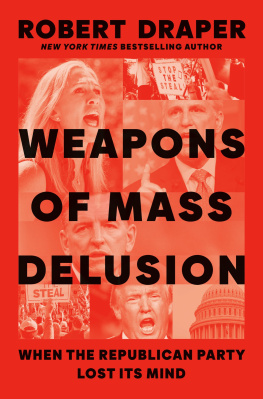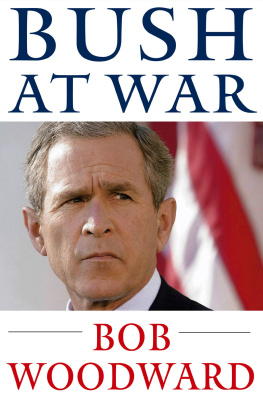Robert Draper - To Start a War: How the Bush Administration Took America into Iraq
Here you can read online Robert Draper - To Start a War: How the Bush Administration Took America into Iraq full text of the book (entire story) in english for free. Download pdf and epub, get meaning, cover and reviews about this ebook. year: 2020, publisher: Penguin Publishing Group, genre: Detective and thriller. Description of the work, (preface) as well as reviews are available. Best literature library LitArk.com created for fans of good reading and offers a wide selection of genres:
Romance novel
Science fiction
Adventure
Detective
Science
History
Home and family
Prose
Art
Politics
Computer
Non-fiction
Religion
Business
Children
Humor
Choose a favorite category and find really read worthwhile books. Enjoy immersion in the world of imagination, feel the emotions of the characters or learn something new for yourself, make an fascinating discovery.
- Book:To Start a War: How the Bush Administration Took America into Iraq
- Author:
- Publisher:Penguin Publishing Group
- Genre:
- Year:2020
- Rating:5 / 5
- Favourites:Add to favourites
- Your mark:
- 100
- 1
- 2
- 3
- 4
- 5
To Start a War: How the Bush Administration Took America into Iraq: summary, description and annotation
We offer to read an annotation, description, summary or preface (depends on what the author of the book "To Start a War: How the Bush Administration Took America into Iraq" wrote himself). If you haven't found the necessary information about the book — write in the comments, we will try to find it.
Robert Draper: author's other books
Who wrote To Start a War: How the Bush Administration Took America into Iraq? Find out the surname, the name of the author of the book and a list of all author's works by series.
To Start a War: How the Bush Administration Took America into Iraq — read online for free the complete book (whole text) full work
Below is the text of the book, divided by pages. System saving the place of the last page read, allows you to conveniently read the book "To Start a War: How the Bush Administration Took America into Iraq" online for free, without having to search again every time where you left off. Put a bookmark, and you can go to the page where you finished reading at any time.
Font size:
Interval:
Bookmark:

Pope Francis and the New Vatican (with David Yoder)
Do Not Ask What Good We Do: Inside the U.S. House of Representatives
Dead Certain:The Presidency of George W. Bush
Hadrians Walls
Rolling Stone Magazine: The Uncensored History

PENGUIN PRESS
An imprint of Penguin Random House LLC
penguinrandomhouse.com
Copyright 2020 by Robert Draper
Penguin supports copyright. Copyright fuels creativity, encourages diverse voices, promotes free speech, and creates a vibrant culture. Thank you for buying an authorized edition of this book and for complying with copyright laws by not reproducing, scanning, or distributing any part of it in any form without permission. You are supporting writers and allowing Penguin to continue to publish books for every reader.
LIBRARY OF CONGRESS CATALOGING-IN-PUBLICATION DATA
Names: Draper, Robert, author.
Title: To start a war : how the Bush Administration took America into Iraq / Robert Draper.
Other titles: How the Bush Administration took America into Iraq
Description: New York : Penguin Press, [2020] | Includes index.
Identifiers: LCCN 2020001715 (print) | LCCN 2020001716 (ebook) | ISBN 9780525561040 (hardcover) | ISBN 9780525561057 (ebook)
Subjects: LCSH: Iraq War, 20032011Causes. | Iraq War, 20032011Decision making. | Bush, George W. (George Walker), 1946Military leadership. | United StatesPolitics and government20012009.
Classification: LCC DS79.757 .D73 2020 (print) | LCC DS79.757 (ebook) | DDC 956.7044/310973dc23
LC record available at https://lccn.loc.gov/2020001715
LC ebook record available at https://lccn.loc.gov/2020001716
Cover design by Christopher Brian King
pid_prh_5.5.0_c0_r0
To Kirsten
A man is not deceived by others; he deceives himself.
JOHANN WOLFGANG VON GOETHE



This is a story bracketed by the two defining tragedies of the twenty-first century. The first was an unprovoked attack on Americas homeland that left nearly three thousand dead. The second, eighteen months later, was an act of war by America against a sovereign nation that had neither harmed the United States nor threatened to do so. The death toll from the latter would ultimately eclipse that from the former by more than a hundredfold.
The two grim events are unalterable facts of history. What took place between them, connecting the one to the other, is arguably the looming riddle of our time, for all that it asks about Americas self-awareness and moral presence in the world today. Ive attempted to solve that riddle here.
Necessarily at the center of this tale is President George W. Bush. Profoundly unpopular when he left office in January 2009in no small measure due to the events described hereBush has since benefited from times leavening of passions, as well as a nationwide yearning for the kind of decency that his family long epitomized. This book seeks to contribute to historys understanding of Americas forty-third president. I hope to do so through the careful telling of Bushs single most consequential act: a long and costly war waged by a commander in chief who sincerely believed he had little choice in the matter.
The decision to invade Iraq was Bushs alone to make. But he had an abundance of help. Some in the upper tiers of the administration vigorously urged that decision. Others did what they could to make his decision less difficult. None of them advised him to decide otherwise. Those lower down the Bush administrations food chain who would have counseled against the decision variously did not speak up or were not given the chance to speak or did speak but went unheeded.
The story I aim to tell is very much a human narrative of patriotic men and women who, in the wake of a nightmare, pursued that most elusive of dreams: finding peace through war.

At first Paul Wolfowitz mistook the tremors in the Pentagon for an earthquake. Such an event would have been rare in the nations capital, but far more fathomable than what had in fact occurred at the opposite end of the building. It took a few bewildered seconds for him to connect the sudden pandemonium just outside his doorway with the events in New York he had seen on his office television less than a half hour earlier.
Uniformed officers entered the deputy secretary of defenses office and instructed him to evacuate immediately. Wolfowitz and his staffers hurried down the E Ring corridor. The entire Pentagon work force, thousands of them, assembled outside on the parade grounds. Black smoke swirled over the western side of the building where American Airlines Flight 77 had completed its path of destruction a few minutes before, at 9:37 on the morning of September 11, 2001.
Even when he was intended to be the center of attention, Wolfowitz cut an indistinct presence. He was fifty-seven and a father of three, recently divorced, a slight, fast-graying academic for whom certain big thoughts were all-consuming and everything elsemanner of dress, posture, hair care, time of the next appointment, sleepwere relegated to afterthought. His default expression was one of mildly skeptical consideration, as if perusing the menu at an overpriced restaurant.
For the past three decades, he had been a sort of backstage eminence in the Washington hierarchy, an important man to more important men. That was about to change. But at this moment, Paul Dundes Wolfowitz was just another vulnerable federal employee standing under an empty blue sky with the ruins of his office building before him.
A half hour before, he had just concluded a breakfast in the Pentagon with Defense Secretary Donald Rumsfeld and nine Republican members of the House Armed Services Committee. At some point during the breakfast, Rumsfeld had predicted that, while Americans were currently luxuriating in peacetime, an event somewhere in the world will be sufficiently shocking that it will remind the American people and their representatives in Washington how important it is for us to have a strong national defense.
Eventually, after several helpless minutes on the parade grounds, Wolfowitz insisted to his aides that he be allowed to return inside. They escorted him to the National Military Command Center, in the basement. Rumsfeld was already there, along with Richard Myers, the vice chairman of the Joint Chiefs. They were discussing United Flight 93, which had just crashed somewhere northeast of Camp David, according to the Air Forces Northeast Air Defense Sector. At issue was whether to elevate the nations threat level to DEFCON 3.
Font size:
Interval:
Bookmark:
Similar books «To Start a War: How the Bush Administration Took America into Iraq»
Look at similar books to To Start a War: How the Bush Administration Took America into Iraq. We have selected literature similar in name and meaning in the hope of providing readers with more options to find new, interesting, not yet read works.
Discussion, reviews of the book To Start a War: How the Bush Administration Took America into Iraq and just readers' own opinions. Leave your comments, write what you think about the work, its meaning or the main characters. Specify what exactly you liked and what you didn't like, and why you think so.













